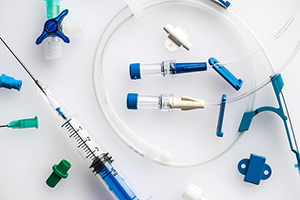In a retrospective cohort study reported in a research letter in JAMA Surgery, Stokes et al found that risk of minor bleeding events during central venous catheter placement in pediatric patients with cancer was significantly increased among those with platelet counts < 50 × 103/μL at the time of catheter placement.
As stated by the investigators, “Tunneled central venous catheters are frequently required in pediatric patients with cancer, but data on platelet transfusion thresholds in this population are limited. The commonly used threshold of 50 × 103/μL … is based on expert opinion.”

Photo credit: Getty
Study Details
The study included 235 patients younger than age 18 (median = 6 years, interquartile range = 3–12 years) who underwent central venous catheter placement at a tertiary pediatric hospital (Shriners Hospital for Children Northern California) between January 2014 and December 2019. The primary outcome was perioperative bleeding.
Minor bleeding was defined as a hematoma or oozing requiring pressure or a topical hemostatic agent. Major bleeding was defined as bleeding requiring red blood cell transfusion, return to the operating room, or any invasive procedure for bleeding.
Key Findings
A total of 279 central venous catheter placements in the 235 patients were included in the analysis.
At time of catheter placement, 22 patients (7.8%) had platelet counts < 50 × 103/μL. Of these, 13 (59.1%) received a planned intraoperative platelet transfusion, with preoperative platelet counts in these patients not differing from those who did not receive transfusion (34 vs 41 × 103/μL, P = .23).
The overall incidence of perioperative bleeding was 3.2% (n = 9). Bleeding was significantly more common among patients with preoperative platelet counts < 50 × 103/μL, occurring in 3 (13.6%) of 22 placements vs 6 (2.3%) of 257 placements among those with counts ≥ 50 × 103/μL (P = .03).
Minor bleeding occurred in three patients (13.6%) vs three patients (1.2%; P = .01). Major bleeding occurred in 0 patients vs 3 patients (1.1%).
On multivariate analysis adjusting for age, weight, preoperative hemoglobin level, solid tumor vs hematologic malignancy, and use of a Broviac catheter vs a portacath, only a preoperative platelet count < 50 × 103/μL was a significant risk factor for perioperative bleeding complications (adjusted odds ratio = 6.3, 95% confidence interval = 1.3–30.0, P = .02).
The investigators concluded: “To our knowledge, this was the largest study evaluating the association of preoperative thrombocytopenia with bleeding risk during central venous catheter placement in pediatric patients with cancer…. The findings suggest that a platelet count below 50 × 103/μL may be associated with increased rates of minor bleeding complications in pediatric patients with cancer; however, major bleeding complications are rare and may not be associated with this threshold. For patients with thrombocytopenia, the risk of minor bleeding complications must be weighed against the risk of receiving platelet transfusions.”
Sarah C. Stokes, MD, of the Department of Surgery, University of California, Davis, is the corresponding author for the JAMA Surgery article.
Disclosure: The study was supported by a grant from the National Center for Advancing Translational Sciences, which is funded by the National Institutes of Health. For full disclosures of the study authors, visit jamanetwork.com.

